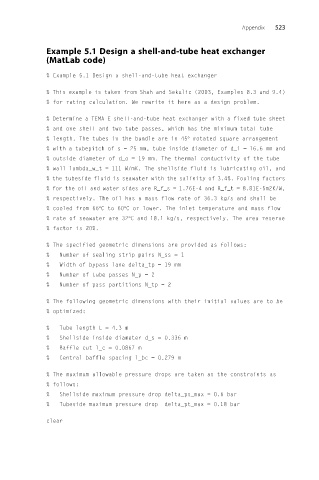Page 540 - Design and Operation of Heat Exchangers and their Networks
P. 540
Appendix 523
Example 5.1 Design a shell-and-tube heat exchanger
(MatLab code)
% Example 5.1 Design a shell-and-tube heat exchanger
% This example is taken from Shah and Sekulic (2003, Examples 8.3 and 9.4)
% for rating calculation. We rewrite it here as a design problem.
% Determine a TEMA E shell-and-tube heat exchanger with a fixed tube sheet
% and one shell and two tube passes, which has the minimum total tube
% length. The tubes in the bundle are in 45° rotated square arrangement
% with a tubepitch of s = 25 mm, tube inside diameter of d_i = 16.6 mm and
% outside diameter of d_o = 19 mm. The thermal conductivity of the tube
% wall lambda_w_t = 111 W/mK. The shellside fluid is lubricating oil, and
% the tubeside fluid is seawater with the salinity of 3.4%. Fouling factors
% for the oil and water sides are R_f_s = 1.76E-4 and R_f_t = 8.81E-5m2K/W,
% respectively. The oil has a mass flow rate of 36.3 kg/s and shall be
% cooled from 66°Cto60°C or lower. The inlet temperature and mass flow
% rate of seawater are 32°C and 18.1 kg/s, respectively. The area reserve
% factor is 20%.
% The specified geometric dimensions are provided as follows:
% Number of sealing strip pairs N_ss = 1
% Width of bypass lane delta_tp = 19 mm
% Number of tube passes N_p = 2
% Number of pass partitions N_tp = 2
% The following geometric dimensions with their initial values are to be
% optimized:
% Tube length L = 4.3 m
% Shellside inside diameter d_s = 0.336 m
% Baffle cut l_c = 0.0867 m
% Central baffle spacing l_bc = 0.279 m
% The maximum allowable pressure drops are taken as the constraints as
% follows:
% Shellside maximum pressure drop delta_ps_max = 0.6 bar
% Tubeside maximum pressure drop delta_pt_max = 0.18 bar
clear

